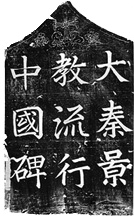
Dated 781 CE, Tang dynasty
Ink rubbing on paper
52.23 x 31.91 cm
Acquisition numbers: #92.78.1
Gift of James K. Penfield
Image courtesy of the Seattle Art Museum (copyright reserved)
This rubbing appears to be taken the famous Nestorian Tablet, discovered in Xian in 1625. This stone stele was inscribed both in Syrian and with Chinese characters by a priest of the Nestorian Church in 781, commemorating the coming of the "Luminous Religion" to China from Syria. Numerous copies of the Nestorian Tablet have been made; they can be found today in such diverse places as Mt. Koya, Japan as well as in the Musée Guimet in Paris. The original stele is preserved today in Xian, in a hall in dedicated to preserving ancient stone stele known as the Peilin, or "Forest of Tablets."
The Nestorian Tablet stands almost ten feet high, and is decorated with carved dragons and a cross at the top. This rubbing in the Seattle Art Museum collection captures the introductory text ("Tablet [eulogizing the] spread of the Luminous Religion from Syria to China") and the distinctive cross motif. In his article "The First Nestorian Mission to China," Robert Oppenheim discusses the incised cross at the head of the monument, depicted as emerging from a lotus and stylized clouds. Oppenheim determines that this design symbolically represents the superiority of Nestorianism to Taoism (represented with clouds) and Buddhism (represented by the lotus).1